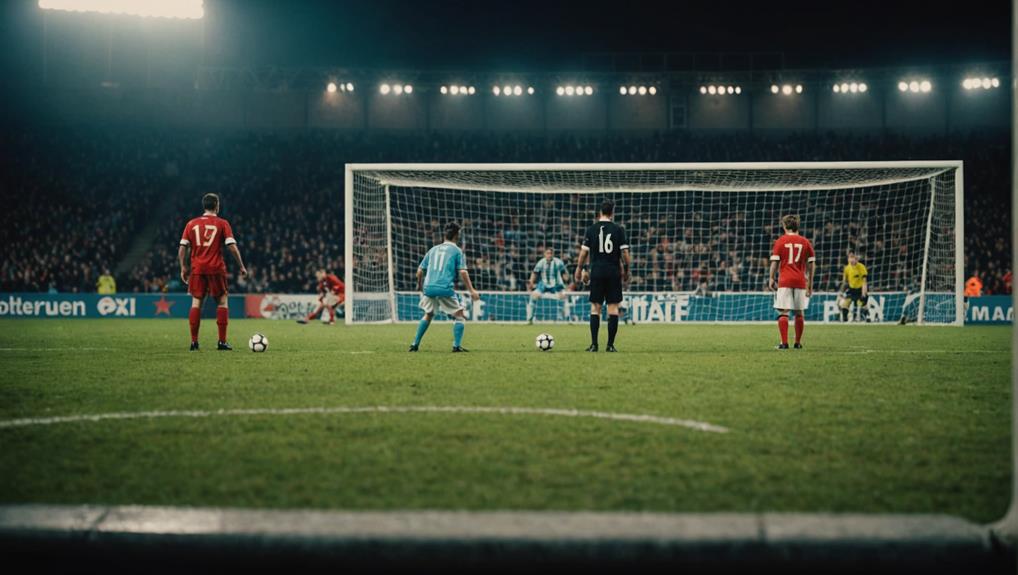
Understanding the Penalty Box in Soccer
July 10, 2024In soccer, the penalty box sits 18 yards from the goal line, an essential zone demanding defensive focus. Keepers rule inside, handling the ball with hands and directing defense during kicks. Fouls in this area often mean penalty kicks, a pivotal moment in matches. Defenders must mark tightly, strategize set-piece plays, and communicate effectively to prevent goals. Penalties can make or break games, requiring skillful shot placement and nerves of steel. Want to know more about the tactics and rules shaping the outcome in this high-stakes area of the pitch?
Importance of the Penalty Box
Understanding the significance of the penalty box in soccer is essential for players and coaches alike to grasp its strategic importance on the field. The penalty box, a pivotal area located 18 yards from the goal line, plays a vital role in the game. It's within this strategic area that penalty kicks are awarded for fouls committed by defending players.
The defending team must exhibit discipline within the penalty box to prevent conceding high-scoring opportunities to the opposition. Fouls committed inside the penalty box can result in penalty kicks, presenting a significant chance for the attacking team to score.
Additionally, goalkeepers have the privilege of using their hands within the penalty box to defend against shots on goal. The penalty box isn't only a goal area but also a key defensive zone where teams must maintain composure and tactical awareness to thwart potential scoring chances.
Goalkeeper Privileges and Responsibilities
Goalkeepers within the penalty area enjoy specific privileges and responsibilities that set them apart from other players on the soccer field. Inside the penalty area, goalkeepers have the unique ability to handle the ball with their hands, providing them with an important defensive advantage. This privilege allows goalkeepers to make saves and clearances using their hands to prevent goals.
Additionally, within this designated area, goalkeepers are also responsible for organizing their defense, directing players, and positioning themselves strategically to protect the goal.
Furthermore, goalkeepers have the privilege of taking goal kicks from anywhere inside the penalty area, enabling them to restart play efficiently. Opponents must be cautious not to impede goalkeepers within the penalty area, as this can lead to fouls and potentially penalty kicks being awarded. In such situations, goalkeepers play a significant role in defending against penalty kicks by positioning themselves to stop incoming shots and protect their goal.
Fouls and Penalty Kicks
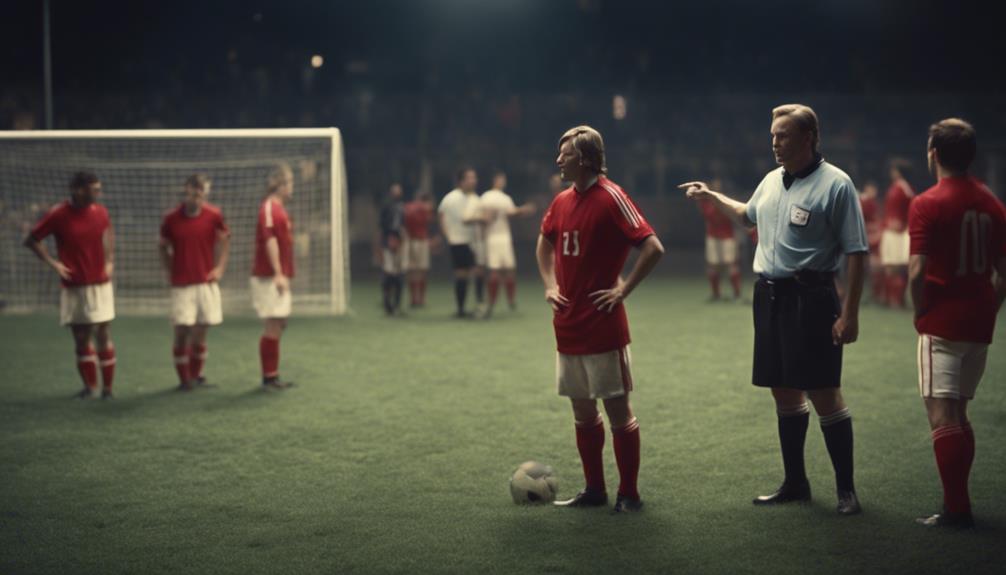
When a foul is committed inside the penalty box in soccer, it can lead to a penalty kick being awarded to the attacking team. Penalty kicks are taken from the penalty spot, situated 12 yards from the goal line in the center of the penalty area.
During a penalty kick, defending players must remain outside the penalty box, except for the goalkeeper and the player taking the kick. The penalty area, extending 18 yards from the goal line, is an important area where fouls can create significant scoring opportunities.
The penalty box is a key area on the soccer field where matches can be heavily influenced by fouls and penalty kick decisions. The goalkeeper plays a critical role during penalty kicks, as they're the last line of defense standing between the penalty taker and the goal.
Successful penalty kicks can often turn the tide of a game, making fouls in the penalty box a high-stakes situation for both teams.
Strategic Plays in the Penalty Box
Strategically positioning defenders and communicating effectively are essential elements in executing successful plays within the penalty box in soccer. Defenders must mark opposing players tightly to prevent scoring opportunities, while goalkeepers need to anticipate shots and organize their defense to make important saves.
Set-piece plays, such as corner kicks and free kicks, are commonly used by teams to create goal-scoring chances within the penalty box. Defending teams focus on quickly clearing the ball out of the box to minimize the risk of conceding goals, often employing tactics to disrupt offensive plays.
On the other hand, offensive players strategically position themselves to exploit gaps in the defense and capitalize on scoring opportunities. By finding spaces in the penalty box and making well-timed runs, these players can increase the likelihood of putting the ball into the back of the net.
Effective communication and coordination between players, defenders, goalkeepers, and set-piece executions play a significant role in determining the outcome of plays within the penalty box.
Impact on Match Outcomes
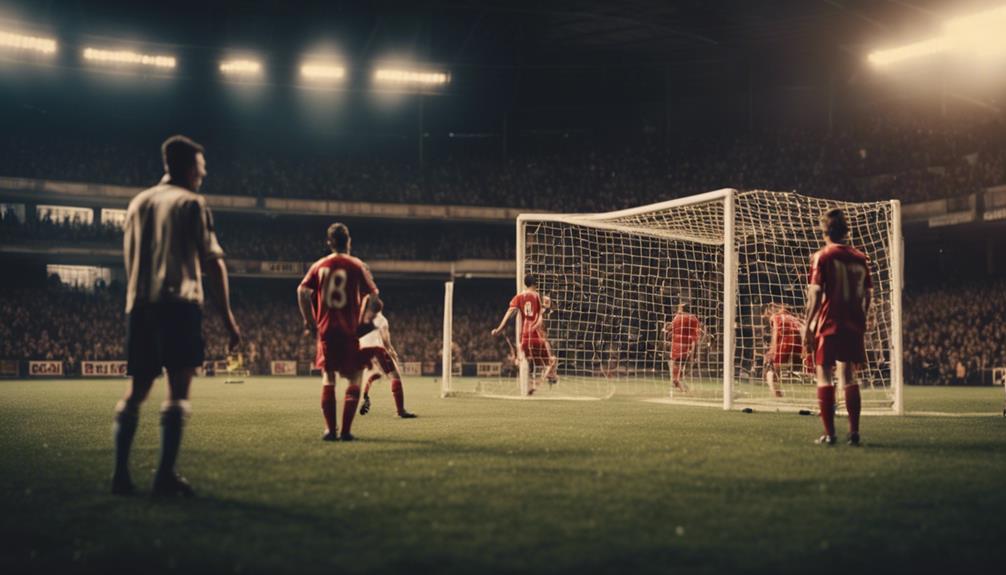
The impact of the penalty box on match outcomes is undeniable, shaping the dynamics of play and influencing the final result. Fouls committed within the penalty box can lead to penalty kicks, presenting prime scoring opportunities for the attacking team. These penalty kicks often result in goals, directly affecting the scoreline and potentially determining the winner of the match.
Defending teams must exercise caution and discipline in the penalty area to prevent conceding penalties and avoid giving their opponents an advantage. The ability to defend the penalty box effectively can sway the momentum of the game and have a substantial impact on the outcome.
Coaches and players must understand the consequences of fouls in this critical area, strategizing to minimize the risk of conceding penalties and maximizing their own scoring opportunities. The penalty box serves as a focal point where matches can be won or lost, emphasizing the importance of disciplined defending and strategic play in securing positive match outcomes.
Tension and Excitement in the Game
Get ready to experience the electrifying tension and excitement that the penalty box brings to every soccer game. The penalty box is where the heart-pounding moments of penalty kicks unfold, creating a high-stakes atmosphere that keeps fans on the edge of their seats.
Inside this 44-yard long and 18-yard wide box, players face the pressure of converting penalties while goalkeepers work hard to make important saves that can change the course of the game.
The penalty box becomes a battleground where composure and skill are tested to the limit. For the penalty taker, it's a moment of intense focus and nerves, with the weight of the team's hopes resting on their shoulders. Conversely, the goalkeeper must anticipate the shot, making split-second decisions to deny the opposition and keep their team in the game.
This intense drama within the penalty box adds a layer of suspense and excitement to soccer matches, elevating it to an essential element of game strategy.
The strategic decisions made within this confined area often determine the outcome of the game, making every moment inside the penalty box a thrilling spectacle for players and spectators alike.
Penalty Box Rules and Regulations
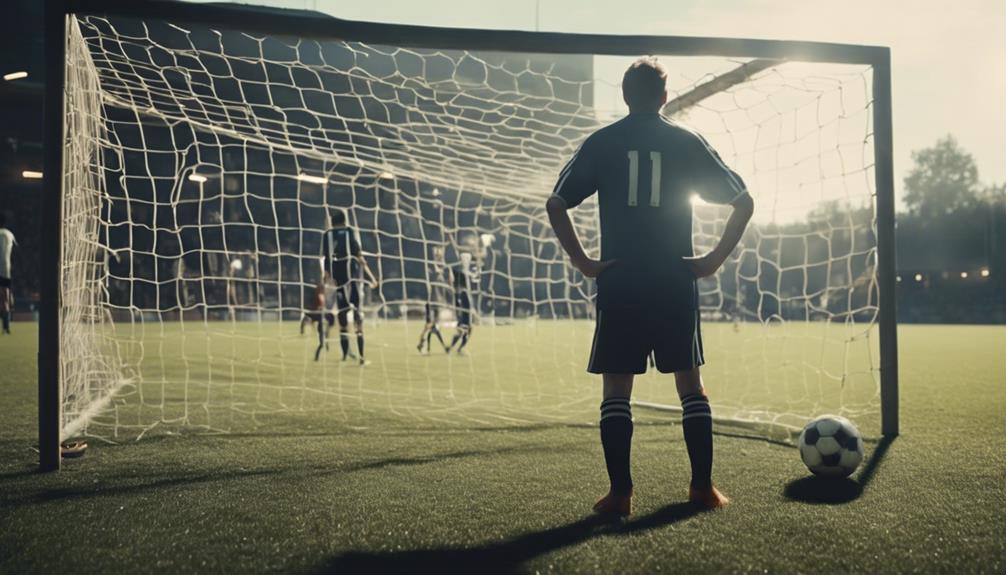
You should know that the penalty box boundary marks the area where important penalty kicks are taken in soccer matches.
Remember that goalkeepers have special privileges within the penalty box, allowing them to use their hands to handle the ball.
It's crucial to understand that fouls committed by the defending team within the penalty box can lead to penalty kicks for the attacking team.
Box Boundary Rules
Understanding the boundary rules of the penalty box in soccer is essential for players and officials to guarantee fair play and proper enforcement of regulations. The penalty box stretches 18 yards from the goal line on both sides, serving as a critical area where key plays unfold.
Within this zone, the goalkeeper holds a unique advantage, being the only player allowed to use their hands to block shots. Additionally, direct free-kick offenses committed inside the penalty box lead to penalty kicks, with the penalty spot situated 12 yards from the goal line at the center of the penalty area.
Defending players must remain outside the penalty box during a penalty kick, except for the goalkeeper and the designated kicker. These boundary rules aim to maintain order and uphold the integrity of the game, ensuring that all actions within the penalty box adhere to the established regulations.
Goalkeeper Penalty Restrictions
Goalkeepers in soccer are granted the unique privilege of using their hands within the penalty box during a game. However, any handling of the ball by the goalkeeper outside the penalty box results in a direct free kick for the opposing team.
These restrictions require goalkeepers to stay within the penalty box during goal kicks and penalty kick situations. It's important for opponents not to impede the goalkeeper's movement or actions within the penalty box to guarantee fair play and maintain safety on the field.
Understanding these rules is vital for goalkeepers to effectively defend their goal and make strategic decisions during gameplay. By adhering to these regulations, goalkeepers can fulfill their role as the last line of defense, protecting their team's goal and contributing to the overall success of the game.
Defending Strategies in the Box
When defending in the soccer penalty box, tight marking of opponents is essential to prevent shots on goal. Goalkeepers play a vital role in organizing the defense, anticipating plays, positioning themselves effectively, and communicating with defenders to guarantee proper coverage.
Teams often adopt zonal marking, where defenders cover specific areas, or man-to-man marking, where each defender is responsible for marking a particular opponent. It's important for defenders to maintain discipline to avoid committing fouls in the penalty area that could lead to penalty kicks for the opposing team.
In addition to marking tightly, defenders must focus on clearing the ball efficiently, blocking shots, and providing support to the goalkeeper. By working together cohesively, defenders can thwart scoring opportunities and maintain a strong defensive presence in the penalty box.
These strategies, combined with effective communication and teamwork, are essential for a successful defense in this critical area of the field.
Scoring Opportunities and Tactics
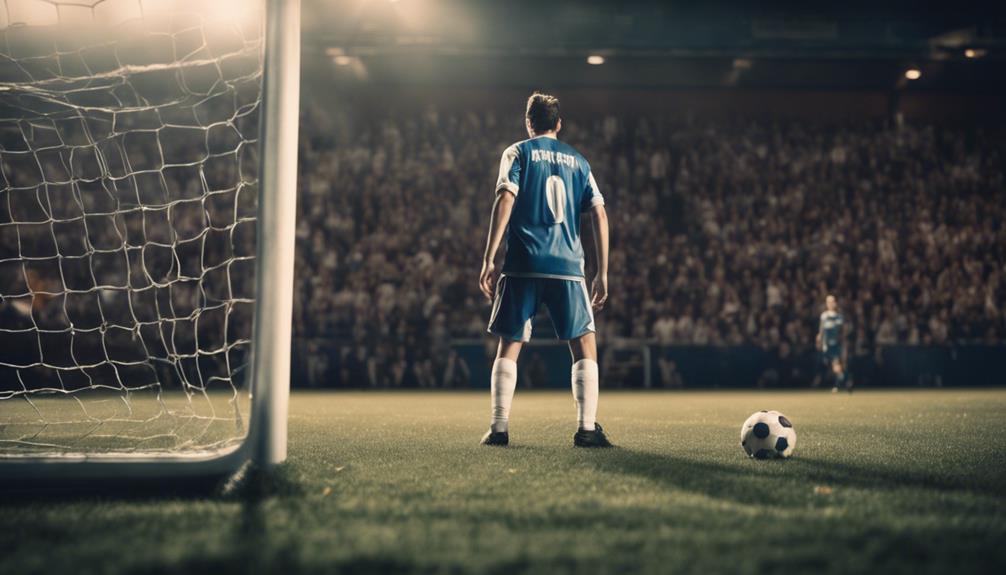
Scoring opportunities in soccer are pivotal moments that can shift the momentum of a game and test the skills of both attackers and defenders. When it comes to scoring goals, penalty kicks are pivotal in determining the outcome of a match. Here are some key points to keep in mind when it comes to scoring opportunities and tactics:
- Penalty Kicks: Penalty kicks are prime scoring opportunities that can make or break a team's success.
- Tactics: Strategic shot placement, power behind the shot, and deceptive techniques are essential tactics when taking penalty kicks.
- Defending Teams: Defending teams must carefully plan their strategies to block penalty kicks and prevent goals in high-pressure situations.
- Goal Conversion: The ability to convert penalty kicks into goals can have a significant impact on the final result of a game.
In soccer, the penalty box is where games can be won or lost, making scoring opportunities and tactics within this area critical for both offensive and defensive success.
Conclusion
As the final whistle blows, the penalty box stands as a symbol of both triumph and defeat. It's where goals are scored, dreams are shattered, and the fate of the game is decided.
In the chaos and intensity of the match, the penalty box remains a sacred ground where players battle for victory and fans hold their breath in anticipation.
Its significance in the game of soccer is undeniable, making it a true arena of emotions and drama.


